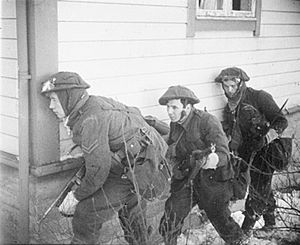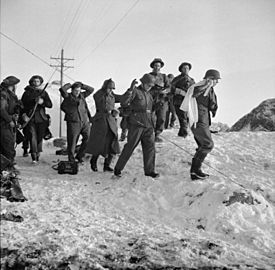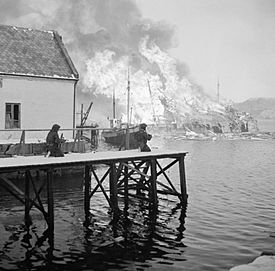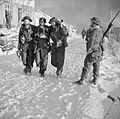Operation Archery facts for kids
Quick facts for kids Operation Archery |
|||||||
|---|---|---|---|---|---|---|---|
| Part of World War II | |||||||
 Commandos in action during the raid |
|||||||
|
|||||||
| Belligerents | |||||||
| Commanders and leaders | |||||||
| Strength | |||||||
|
|
||||||
| Casualties and losses | |||||||
|
|
||||||
| 1 civilian killed | |||||||
Operation Archery, also known as the Måløy Raid, was a special military mission during World War II. It happened on December 27, 1941. British forces, including Commandos, attacked German positions in Vågsøy, an island in Norway. This raid was part of a bigger effort by the Allies against Germany.
British Commandos from different groups took part. These included No. 3 Commando, parts of No. 2 Commando, and a special demolition team. A dozen brave Norwegian soldiers from Norwegian Independent Company 1 also joined the mission. The Royal Navy provided strong support with warships. These included the light cruiser HMS Kenya and four destroyers. Two transport ships, Prince Charles and Prince Leopold, carried the troops. The Royal Air Force also helped with bombers and fighter planes.
Contents
Why the Raid Happened
This mission had two main goals. The first was to destroy factories that made fish-oil. The Germans used this oil to create powerful explosives. By destroying these factories, the Allies hoped to weaken Germany's war efforts.
The second goal was to make Germany send more soldiers to Norway. If Germany had to keep more troops in Norway, it would mean fewer soldiers for the Eastern Front. This was where Germany was fighting the Soviet Union. By doing this, the Allies hoped to help their friends on the Eastern Front.
Planning the Attack
The commando force had 570 soldiers. They split into five groups, each with a specific task:
- One group was to secure the area north of Måløy town. They would also stop any German reinforcements.
- Another group was to take control of Måløy town itself.
- A third group had to clear out German forces on Måløy Island. This island was important because it overlooked the town.
- The fourth group's job was to deal with a strong German position at Holvik, west of Måløy.
- The last group stayed offshore as a backup, ready to help wherever needed.
The Raid Begins
The attack started at dawn, after the navy fired many shells at German positions. Most of the goals were achieved quickly, except for Måløy town. The German soldiers in the town fought back much harder than expected. The British didn't know that a special unit of experienced German mountain troops was on leave there. These German soldiers were good at sniping and street fighting. This turned the mission into a tough house-to-house battle.
The British commander, John Durnford-Slater, had to call in the backup troops. Some local Norwegian people bravely helped the commandos. They carried ammunition, grenades, and other explosives. They also helped carry away the wounded soldiers.
Around 2:00 PM, the commandos began to leave. They had successfully destroyed four factories, the fish-oil stores, and many other military buildings. They also blew up ammunition and fuel supplies. Much of the town was left burning. The navy ships also did their part. They sank 10 German ships. Some of these ships were being sunk by the Germans themselves to prevent them from being captured. The German coastal guns had some technical problems, so they weren't very effective. Only one of their large guns managed to hit the British cruiser.
What Happened Next
The British Royal Navy did not lose any ships. However, four sailors were killed and four were wounded. The Commandos lost 17 soldiers and 53 were wounded. Captain Martin Linge, the leader of the Norwegian soldiers, was sadly killed during an attack on the German headquarters. Eight Royal Air Force planes were also shot down. A Norwegian civilian was also hurt by flying debris and died later.
The commandos killed at least 120 German defenders. They also captured 98 German soldiers. They even brought back a complete copy of the German Naval Code, which was very valuable. Captain O'Flaherty was shot by a sniper and lost an eye. He later wore an eye-patch. You can see him in the image of the 'Wounded British officer' being helped by two other soldiers.
The British also brought back some Norwegians who had helped the Germans (called "Quislings"). More than 70 loyal Norwegians (called "Jøssing") who supported the Allies were also brought to safety. At the same time as this raid, another mission called Operation Anklet took place in the Lofoten Islands. This was a diversion to distract the Germans.
The raid was so successful that it convinced Adolf Hitler to send 30,000 more troops to Norway. He also ordered more defenses to be built along the coast and inland. Hitler thought the British might try to invade northern Norway to put pressure on Sweden and Finland.
Images for kids




